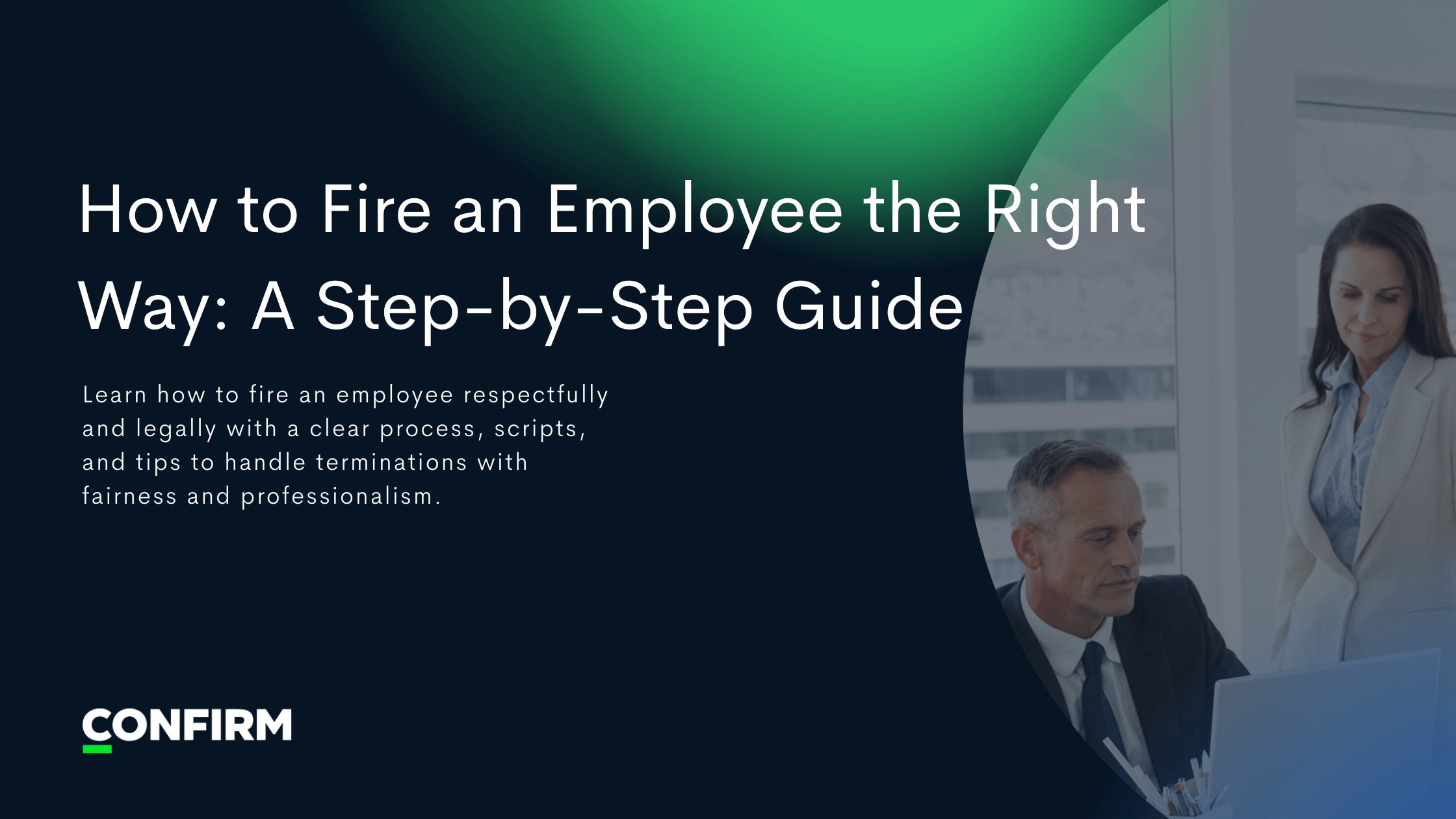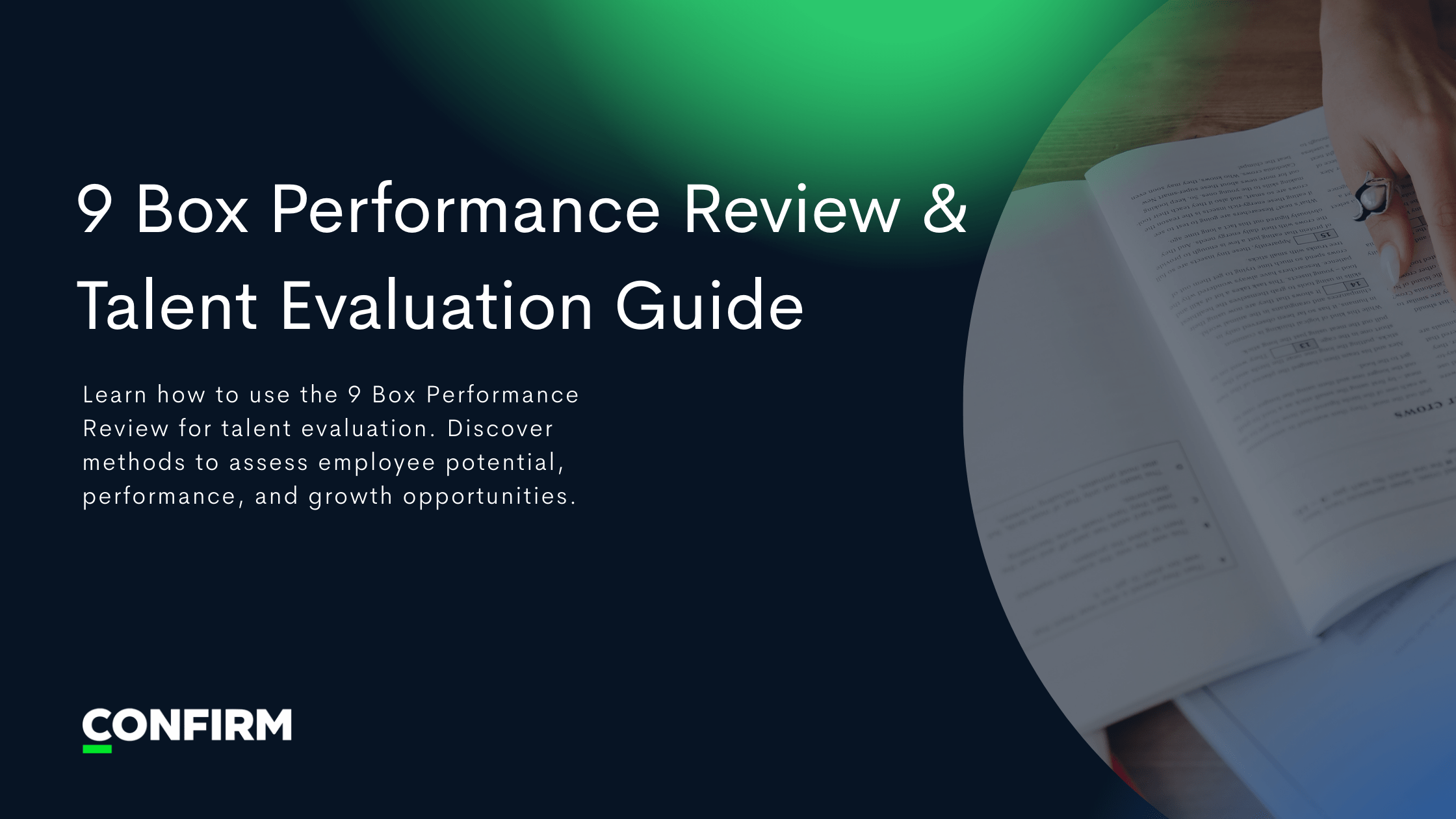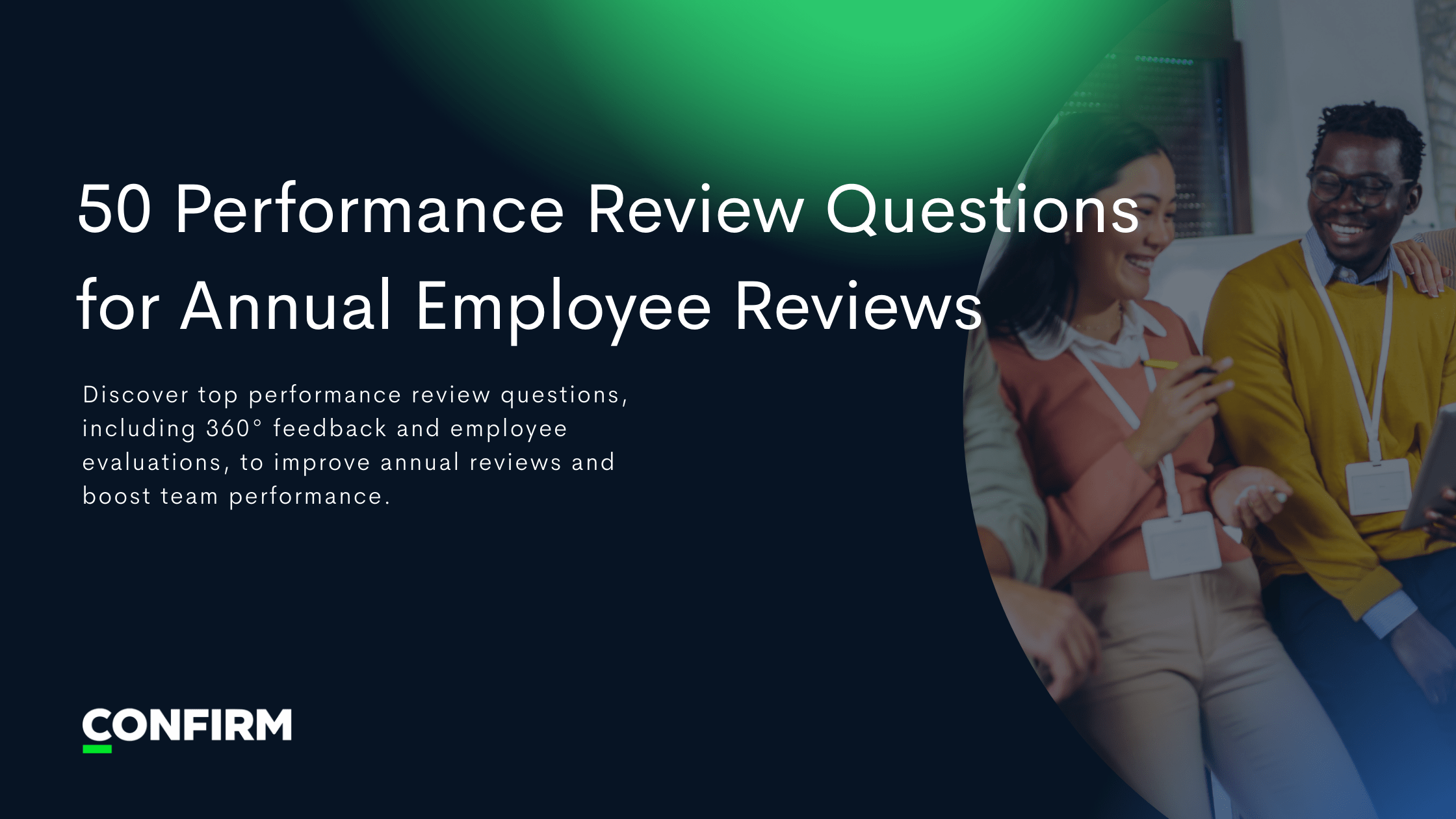
Blog post
How to Fire an Employee the Right Way: A Step-by-Step Guide
Learn how to fire an employee respectfully and legally with a clear process, scripts, and tips to handle terminations.

Firing an employee is one of the most difficult responsibilities in people leadership. Done poorly, it damages trust, increases legal risk, and harms your culture. Done well, it’s respectful, defensible, and humane—and it reinforces performance standards for the team.
Below is a practical, legally aware (but not legal advice) playbook on how to fire an employee, including reasons that commonly justify termination, a thorough step‑by‑step process, sample language for the meeting, and post‑termination best practices. Throughout, you’ll see callouts where Confirm’s performance platform can help you build fair, evidence‑based decisions that reduce bias and keep your process clean.
Reasons to fire an employee
Before you even consider how to terminate an employee, ensure you have a legitimate, well‑documented reason aligned with company policy and local law. Common reasons include:
1. Poor performance
- Consistent failure to meet documented performance expectations or goals.
- Patterns verified by manager feedback, peer input, or objective output/quality metrics.
- Tip: Systems like Confirm help leaders aggregate performance signals across the organization—not just one manager’s viewpoint—using Organizational Network Analysis (ONA) to surface how a person’s work is perceived by collaborators. This helps minimize single‑rater bias before a termination decision is made.
2. Sexual harassment
- Substantiated violations of your anti‑harassment policy following a fair, thorough investigation.
- Typically warrants immediate termination to protect employee safety.
3. Theft or fraud
- Proven misappropriation of funds, assets, or time record fraud.
- Usually a “for cause” termination, often immediate.
4. Safety violations
- Willful or negligent behavior creating unsafe conditions, especially in regulated environments.
5. Attendance issues
- Excessive unexcused absences or tardiness in violation of policy, after progressive discipline and clear expectations.
6. Disrespectful behavior
- Abusive conduct, insubordination, or behavior that undermines team cohesion—when documented, coached, and unresolved.
Important: Always consult counsel on applicable laws (e.g., at‑will vs. just‑cause, protected leaves, accommodations). When in doubt, pause and review with HR and legal.
Step‑by‑Step Guide on How to Fire an Employee
Step 1: Gather and Organize All Required Documentation
- Performance evidence: goals, KPI results, 360/peer input, written feedback, performance‑improvement plan (PIP) progress.
- Conduct evidence: complaint details, investigation notes, witness statements, policy citations.
- Communication artifacts: emails or notes demonstrating clear expectations and coaching.
- Prior corrective actions: verbal/written warnings with dates and outcomes.
- Pay/benefits info: final paycheck requirements, accrued PTO, commissions, vesting
- Access inventory: laptop, badges, accounts, systems.
How Confirm helps: Instead of hunting through docs and disparate tools, Confirm centralizes performance reviews, calibrated talent signals mapped by ONA, and AI summaries you can export into a tidy packet—so your rationale is consistent and traceable.
Step 2: Review Legal Considerations and Risks
- Validate non‑discriminatory rationale unrelated to protected classes or protected activities.
- Confirm compliance with required notice periods, final wage timing, and any state‑specific forms.
- Check whether the employee recently requested leave, accommodation, or reported wrongdoing.
- Align on severance approach, releases, and post‑employment obligations (e.g., non‑compete, if applicable).
Disclaimer: This article is for information only and not legal advice. Always consult employment counsel for your jurisdiction.
Step 3: Plan and Conduct the Termination Meeting Professionally
- Who should attend: Manager + HR partner (and security on standby if needed).
- Where: Private, neutral, distraction‑free (for remote, use a secure video meeting without recordings).
- When: Early in the day and early in the week; avoid holidays.
- How long: 10–15 minutes; this is not a debate.
Suggested script (performance):
“Jane, thank you for meeting. We’ve reviewed your performance against the goals outlined in your PIP on [date]. Despite coaching and support, the required improvements have not been met. As a result, your employment with [Company] will end today. This decision is final. HR will walk you through pay, benefits, and transition support. I want to recognize your contributions in [X]; we’ll help make the transition as smooth as possible.”
Suggested script (misconduct):
“John, following our investigation into [policy], we confirmed violations of [specific policy]. Based on the findings, your employment with [Company] ends effective today. HR will explain final pay and logistics. The decision is final.”
If asked for details: Keep it factual and brief. Avoid debates; reference prior documentation or the completed investigation.
Step 4: Offer Support and Transition Resources to the Employee
- Severance & benefits: Outline final pay, PTO payout, and COBRA/benefit continuation where relevant.
- Outplacement: Offer résumé support, job search resources, or coaching if appropriate.
- References: If you provide a neutral or positive reference, define the policy now.
- Employee assistance program (EAP): Remind them of confidential support resources.
Step 5: Complete Post‑Termination Administrative Tasks
- Recover assets: Badge, laptop, phone, credit cards, keys.
- Disable access: Email, SaaS apps, data drives, code repos, VPN.
- Change ownership: Reassign open tasks, deals, tickets, or customer accounts.
- Update records: HRIS, payroll, equity systems; issue required notices and final pay on time.
- Document the meeting: Who attended, time/date, what was communicated, employee response.
Step 6: Schedule a Follow‑Up if Appropriate
- Brief check‑in (24–48 hours) to confirm logistics (equipment return, benefits questions).
- For the team: Schedule a measured, privacy‑respecting announcement that resets focus on goals and coverage.
Step 7: Ensure Confidentiality and Protect Employee Privacy
- Share “need to know” only.
- Communicate to the team without disparagement: “Alex is no longer with the company. We appreciate their contributions and wish them well. For questions about work coverage, contact…”
Step 8: Prepare Logistical Details for the Employee’s Final Day
- Remote/Hybrid: Provide prepaid return shipping and clear timelines.
- On‑site: Offer time to collect personal items privately, with an HR escort if needed.
- Data hygiene: Confirm personal files are retrieved and company IP remains protected.
Step 9: Evaluate and Document the Entire Termination Process
- Conduct a post‑mortem: Did we set clear expectations? Provide coaching? Apply policy consistently?
- Identify manager capability gaps; reinforce training.
- Use ONA insights: Confirm can show whether performance concerns were manager‑specific or reflected by the broader network—useful for learning, not punishment.
Common Mistakes to Avoid When Terminating an Employee
- Weak documentation: Terminating without a clear, written performance or conduct trail.
- Mixed messages: Sugarcoating the reason, inviting argument, or implying reconsideration.
- Public spectacle: Allowing gossip or visible security escorts without necessity.
- Timing missteps: Friday evening terminations that leave the person without HR support for days.
- Access gaps: Forgetting to immediately revoke systems—risking data loss.
- Inconsistent policy application: Treating similar cases differently without a legitimate reason.
- Manager‑only decisions: Relying on a single manager’s opinion; use multi‑rater inputs (e.g., Confirm’s ONA) to reduce bias and ensure fairness in decisions.
FAQs
What is the proper process for firing an employee?
A defensible process includes: (1) verifying legitimate reason; (2) gathering documentation; (3) legal review; (4) a short, respectful termination meeting; (5) clear written follow‑up covering pay/benefits; (6) recovering assets and disabling access; and (7) documenting the entire process and communicating with the team appropriately. This article’s nine‑step workflow is designed to keep you compliant and humane.
How do you fire someone without causing conflict?
Be direct, brief, and compassionate. Avoid debates. Share the decision and next steps; don’t re‑litigate. Offer transition support. Choose a private setting. Most conflict arises from surprise—reduce it with earlier feedback and transparent expectations.
What documentation is required before termination?
Policies, goals, performance data (including multi‑rater inputs), coaching notes, warnings/PIPs, investigation files (for misconduct), and final pay/benefits calculations. Centralize it so HR and legal can quickly review. Confirm helps by aggregating performance reviews, ONA‑based peer signals, and AI summaries into a single record.
Can you fire someone without a warning?
It depends. For gross misconduct (e.g., harassment, theft, serious safety violations), immediate termination may be appropriate following an investigation. For performance issues, progressive discipline and a documented PIP are best practice. Always check local law and consult counsel.
What should you say during a termination meeting?
Use clear, neutral, and final language: state the decision and reason, outline logistics, and offer support. Avoid evaluative judgments, debates, or surprise feedback. See the scripts above for “performance” and “misconduct” scenarios.
Where Confirm Fits in (and helps you avoid unnecessary terminations)
Even the best termination process can’t fix weak upstream performance management. Confirm’s platform is built to reduce bias and increase visibility before decisions escalate:
- Organizational Network Analysis (ONA): See who actually drives outcomes across teams—uncover hidden high‑impact contributors and spot struggling employees earlier, with evidence beyond a single manager’s opinion.
- AI summaries & one‑click reviews: Turn noisy feedback into clear, auditable summaries you can hand to HR and legal.
- Ease of setup & high adoption: Integrates with your HRIS and collaboration tools so managers and employees actually use it—making your documentation robust and decision‑ready.
Get in touch with our experts today to see how Confirm can help you build fairer, faster performance decisions—and reduce the number of terminations you need to make.
Quick Checklist (copy/paste)
- Legitimate reason aligned to policy and law
- Complete documentation package (performance or misconduct)
- Legal/HR review and sign‑off
- Logistics planned (timing, room/video, attendees, final pay, severance)
- Assets/access list ready
- Clear, brief script prepared
- Outplacement/EAP info ready
- Post‑meeting comms to team drafted
- Process documented for audit/learning
Ready to see Confirm in Action?
See why forward-thinking enterprises use Confirm to make fairer, faster talent decisions and build high-performing teams.









